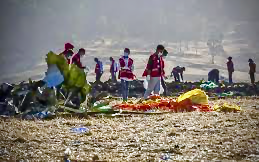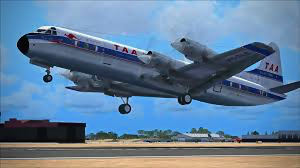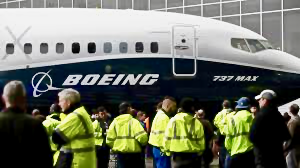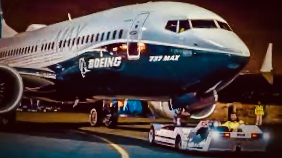Boeing 737: Hitting MAX 2.
As the tragic stories and 737 MAX 8 groundings pile up in the wake of last Sunday’s Ethiopian Airlines ET 302 crash, many questions and factors converge. The months-old Boeing aircraft nose dove barely six minutes after takeoff on a flight from Addis Ababa to Nairobi, Kenya, killing all 157 aboard—many from a virtual United Nations of 35 countries.
Because the accident occurred so similarly and soon after an earlier MAX 8 disaster in Indonesia, the immediate worldwide reaction was: Lion Air JT610 all over again. Calm weather, clear skies, erratic  vertical acceleration and rapid fall, emergency crew distress calls to towers, “Break, break…” frantically requesting return, “Don’t sink, don’t sink…” with pilots clueless as to the source of their aircraft’s flight control problems, “Command…”, struggling to aviate, navigate and communicate, “Pull up, pull up!”
vertical acceleration and rapid fall, emergency crew distress calls to towers, “Break, break…” frantically requesting return, “Don’t sink, don’t sink…” with pilots clueless as to the source of their aircraft’s flight control problems, “Command…”, struggling to aviate, navigate and communicate, “Pull up, pull up!”
Early assessment: New plane, clean record, no maintenance problems cite—then comes the official befuddlement, cautious back-foot conjecture and administrative stonewalling until the black boxes are analyzed and all probative evidence is in. Meanwhile, aviation agencies drag their investigative heels and liable parties layer up with legal teams.
Remember the Electra.
The Ethiopian crash, and its physical/technological contrails, evoke a much earlier series of commercial air tragedies, some 60 years ago. Lockheed Corporation then launched its revolutionary Electra turboprop in 1957, with long-gone Eastern Airlines its initial customer, first taking off in January, 1959.
The Model 188 was a low-wing cantilever ‘monoplane’ with four wing-mounted Allison T56 turbo engines. It could carry 66 to nearly 100 passengers in luxury, depending on configuration, with a range of 2,144 miles—and was a powerful, speedy airliner for its day, cruising at nearly 450 m.p.h. Accordingly, it was order by other major lines like American, Northwest, Braniff and carriers around the world.
But that very power soon proved to be its undoing, literally so. Early on, passengers complained about engine noise and vibration rattling Electra cabins from its massive pitched propellers; wing structures and skins began to overstress from the four engine force. Then came the first major crash: An American Electra on approach to New York’s Laguardia Airport plunged into the East River on February 3, 1959, killing 65. Not long after, Braniff 542 bound for Dallas/NY on September 29, disintegrated over Leon County, Texas, taking 34 lives. On March 17, 1960, Northwest Air’s flight 710, en route from Chicago’s Midway Airport to Miami, broke up over Tell City, Indiana, taking 57 lives. In October 0f 1960, Eastern 375 bound for Atlanta crashed on takeoff from Boston’s Logan Airport, killing 62.
The Eastern Airlines disaster was partially blamed on bird strikes; however the Electra’s problems were soon determined to run much structurally deeper than that. A high power to weight ratio, its huge propellers and relatively short wings, were proving to be too much for the plane, leaving the entire wingspan engulfed in prop wash, eventually tearing its superstructure apart in flight. Moreover, a phenomenon called ‘whirl mode flutter’ wreaked havoc on the wings’ engine mounts.
Lockheed replaced those overworked Electra nacelles, tilting its engines upwards three degrees; The FAA then limited the fleet’s speed, concerned that the four Rolls-Royce Dart engines were simply too powerful for the craft’s own good. The company endeavored to strengthen the wings and engine mounts, but the entire redesign/refit process was becoming increasingly costly. Then by the time KLM 823 crashed on  approach to Cairo on June 12, 1961, killing 20, and Northwest 706 went down on takeoff from Chicago’s O’Hare Airport (bound for Florida), killing 37 September 17, the flying public had lost confidence in the Electra 188 line altogether, well before the then U.S. Civil Aeronautics Authority would decisively act, after the loss of 275+ lives.
approach to Cairo on June 12, 1961, killing 20, and Northwest 706 went down on takeoff from Chicago’s O’Hare Airport (bound for Florida), killing 37 September 17, the flying public had lost confidence in the Electra 188 line altogether, well before the then U.S. Civil Aeronautics Authority would decisively act, after the loss of 275+ lives.
Even though the Chicago-O’Hare accident was actually attributed to maintenance error, the broader verdict was in: Lockheed’s troubled Electra was gradually relegated to small airlines and cargo outfits the world over, many variants flying to this day.
Ethiopian Post-Crash Cascade: Safety Over Profits?
Point being, new design flaws, oversized engine/wing mounting problems: We’ve been here before, not to mention with the ill-fated McDonnell-Douglas DC 10. And as for Boeing, the Chicago/Seattle manufacturer was coming off a 787 Dreamliner lithium-ion battery (thermal runaway) fire fiasco of 2013—and subsequent fleet-wide grounding by the FAA.
While terms like ‘Accidents waiting to happen’ and ‘There’s a sense of urgency’ flooded the media, mainstream to social, the U.S., FAA to Boeing, continued to let the 737 MAX 8 fly. They and the airline industry claimed a lack of sufficient information on ‘systematic performance issues’ at that point made a grounding of the plane unjustified—that it would ‘create economic pressure…that is unjustified at this point. We have to be patient and let the investigators do their job’.
This, even though Ethiopian Air’s routine maintenance check hadn’t revealed any problems, while the Times of Israel quoted an Israeli who had just deboarded the ET302 aircraft in Addis Ababa as saying that very airplane was experiencing mechanical issues on its previous leg up from Johannesburg (shades of JT 610 once again?). What’s more, post-Lion Air U.S. pilot complaints logged to NASA regarding the confusing MCAS technology had already gone unheeded, as had the question of whether overseas flight crews were being adequately trained on the new anti-stall system.
In this context, air travelers banked into the Ethiopian cascade…
Canada, China, India, Indonesia, Russia, Singapore, the UAE, UK and Europe’s entire EASA: By now over 40 countries, scores of airlines, from Fiji and Norwegian to Silk and Turkish Air, had procedurally, ‘prudently’ grounded the Boeing 737 MAX 8/9 aircraft.
In the U.S., pilots and flight attendants unions questioned the safety of the MAX jets, and called for a halt and  investigation. Some aviation experts and legislators said the FAA was ‘dragging its feet’, and demanded an immediate grounding of the MAX 8/9. Former NTSB Chairman, Jim Hall said, “America’s reputation around the world as a leader in aviation safety is going to be impacted because of our failure to put safety first and keep the aircraft on the ground until we’re confident we know what went wrong.”
investigation. Some aviation experts and legislators said the FAA was ‘dragging its feet’, and demanded an immediate grounding of the MAX 8/9. Former NTSB Chairman, Jim Hall said, “America’s reputation around the world as a leader in aviation safety is going to be impacted because of our failure to put safety first and keep the aircraft on the ground until we’re confident we know what went wrong.”
Yet major domestic carriers with substantial 737 MAX fleets like American, United and Southwest Air maintained their schedules (A/A charging change fees), continued operating their MAX flights across the U.S.—whether due to wait-and-see denial or unspoken economic imperatives.
Holding Pattern: Differing conclusions…and Motivations.
In the meantime, a parade of Boeing and airline executives assuringly stood by the MAX 8’s safety and reliability—upright confidence men that they are. Boeing CEO Dennis Muilenburg said further that speculation about “the cause of the accident without all the necessary facts (could) compromise the integrity of the investigation.”
Concurrently the Federal Aviation Administration issued a “continued airworthiness notification” for the MAX 8/9, citing ‘lack of information’ and ‘insufficient justification for grounding the now widely suspect Boeing variant. Despite growing pressure, and nearly 350 fatalities, the agency stated that it is a data-driven, risk analysis organization, and other civil aviation authorities hadn’t “produced (clear) data to us that would warrant action.”
Acting FAA administrator Daniel K. Elwell (formerly with the Boeing trade association) somewhat defensively released a statement that concluded, “In the course of our urgent review of data on the Ethiopian Airlines Flight 302 crash, if any issues affecting the continued airworthiness of the (craft) are identified, the FAA will take immediate and appropriate action.” In other words, only when the data got dire enough to force grounding. Until then, apparently it was let the flyer beware—with echoes of the agency’s erstwhile dual role of regulation and promoting civil aviation, presumably gone by way of the ValueJet disaster in 1996.
To be determined, presumably via the flight’s black boxes (damaged and off to France’s Bureau of Enquiry and Analysis for Civil Aviation Safety for data recovery), is whether the devastating dive was caused by mechanical failure (by a leading African airline with a solid safety record); pilot error (despite his sterling reputation), or perhaps another (flaps down/flaps up) malfunction of the new MCAS anti-stall system (now ploddingly undergoing flight control software enhancement by Boeing  engineers).
engineers).
Well, one person finally did take such warranted action. President Trump, who had earlier tweeted that these planes were too complex to fly and didn’t want “Albert Einstein to be my pilot”, followed Canada’s and EASA’s lead to ground domestic MAX 8s (275 flights per day) “…until further notice.”
The FAA has since announced that new information/ evidence from the crash site and highly defined satellite imagery (vertical speed variations more closely paralleling the Lion Air JT610 failures), according to a repetitive data signature have moved the data driven investigation forward. Not to mention the public outrage and upward pressure, which likely caused Boeing to rapidly change bearing and clamber aboard as 737 MAXs were yanked from U.S. skies.
Beware an AeroIndustrial Complex?
Still, the Ethiopian Air crash’s fall-in-line fallout provides the latest example of the (too) cozy relationship between the world’s largest aircraft manufacturer/exporter and the U.S. agency charged with its oversight and regulation. For openers, the Trump administration’s acting defense secretary, Patrick Shanahan was a Boeing executive for over three decades.
Moreover, CEO Muilenburg’s direct line to the White House, wherein he assured the president that the MAX 8 was safe and airworthy, was product of earlier direct meetings with POTUS at Trump Tower and Mar-A-Lago. Matters discussed (or haggled over, as it were) involved future military jet orders and a new 747 for Air Force One, after which the president said he expected a gold watch at the end of his term for being one of Boeing’s best salesmen. He later proclaimed, “God bless Boeing” upon inspecting a newborn 787 Dreamliner at the plane builder’s South Carolina plant.
Then again, the Boeing Company checks both Republican and Democratic boxes, to the lobbying tune of $16m in 2017 and $15m last year. But pay-to-play is one thing, ply-to-fly something far more VamoSerious indeed.
(Much more to come on this as events unfold…)
<< 737-8: The MAX Factors.
<<< Accident Update: Lion In Wait.
